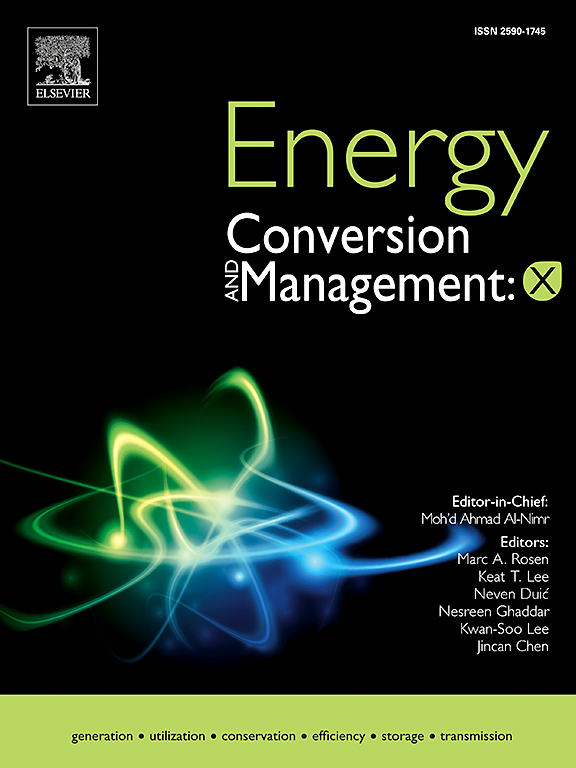光伏电站与电池储能系统耦合的迭代规模确定方法,以确保平稳的电力输出和电力可用性
IF 7.1
Q1 ENERGY & FUELS
引用次数: 0
摘要
光伏(PV)太阳能是一项基础技术,有助于从以化石燃料为主的能源组合过渡到可再生能源比例较高的未来。为此,光伏电站与储能系统相结合,可以积累多余电力,并在光伏发电量发生变化时进行调度,从而实现光伏平滑。虽然光伏电站与电池储能系统(BESS)的耦合提供了一种解决方案,但目前的方法往往需要全面描述电池储能系统的能量容量、额定功率和电池衰减的长期影响之间的相互作用。本文针对这一不足,提出了一种四步方法,可优化光伏电站 BESS 的大小,同时考虑循环和日历老化对系统性能的影响以及电池更换的经济影响。我们使用的模型考虑了光伏组件和两种锂离子电池(LiFePO4,LFP 和 LiNiMnCoO2,NMC)的退化。模拟了一个 16.3 兆瓦的光伏电站和 BESS,以测试该方法。结果表明,额定功率为 1.25 兆瓦、发电量为 2.5 兆瓦时、基于 LFP 的 BESS 可确保在 98% 的时间内稳定输出功率,其变化幅度低于额定光伏电站的 10%。相比之下,基于 NMC 的 BESS 虽然能有效减少不合规情况,但由于需要频繁更换电池,因此成本较高,经济可行性较低。本文介绍的方法和结果为在光伏电站中设计具有成本效益且可靠的储能解决方案提供了宝贵的见解,从而确保符合设定的电力可用性。本文章由计算机程序翻译,如有差异,请以英文原文为准。
Iterative sizing methodology for photovoltaic plants coupled with battery energy storage systems to ensure smooth power output and power availability
Photovoltaic (PV) solar energy is a fundamental technology that will help transition from a fossil fuel–based energy mix to a future with high shares of renewable energy. To do so, PV plants coupled with energy storage systems can accumulate excess power and dispatch it when PV generation changes, performing PV smoothing. While coupling PV plants with battery energy storage systems (BESS) offers a solution, current methodologies often need to thoroughly describe the interplay between BESS energy capacity, power rating, and the long–term impacts of battery degradation. This paper addresses this gap by proposing a four–step methodology that optimizes BESS sizing for PV plants, accounting for both cycling and calendar aging effects on system performance and the economic implications of battery replacements. We use a model that considers the degradation of PV modules and two Li–ion battery types (LiFePO4, LFP, and LiNiMnCoO2, NMC). A 16.3 MW PV plant is simulated along with the BESS to test the methodology. The results indicate that an LFP–based BESS of 2.5 MWh with a rated power of 1.25 MW ensures a stable output power with variation below 10% of the rated PV plant 98 % of the time. In contrast, an NMC–based BESS, while effective in reducing non–compliance, incurs higher costs due to more frequent battery replacements, making it less economically viable. The methodology and results presented in this paper provide valuable insights for designing cost–effective and reliable energy storage solutions in PV plants, ensuring compliance with set power availability.
求助全文
通过发布文献求助,成功后即可免费获取论文全文。
去求助
来源期刊

Energy Conversion and Management-X
Multiple-
CiteScore
8.80
自引率
3.20%
发文量
180
审稿时长
58 days
期刊介绍:
Energy Conversion and Management: X is the open access extension of the reputable journal Energy Conversion and Management, serving as a platform for interdisciplinary research on a wide array of critical energy subjects. The journal is dedicated to publishing original contributions and in-depth technical review articles that present groundbreaking research on topics spanning energy generation, utilization, conversion, storage, transmission, conservation, management, and sustainability.
The scope of Energy Conversion and Management: X encompasses various forms of energy, including mechanical, thermal, nuclear, chemical, electromagnetic, magnetic, and electric energy. It addresses all known energy resources, highlighting both conventional sources like fossil fuels and nuclear power, as well as renewable resources such as solar, biomass, hydro, wind, geothermal, and ocean energy.
 求助内容:
求助内容: 应助结果提醒方式:
应助结果提醒方式:


